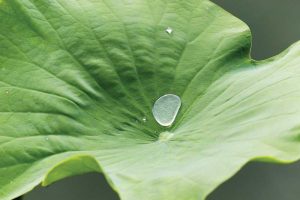
By James Howell
Water intrusion causes significant problems for buildings and can go as far as damaging the structure. The building products industry is continuously looking for new technologies to assist with the prevention of water damage. Nature, as a notorious problem solver, often inspires solutions within the industry.
Complete prevention of water intrusion is important for buildings. Much of the surface area of buildings are covered by paint and coatings, which are made to withstand the punishment of extreme weather, therefore new technology is very much needed in this category. Hydrophobic coatings are using new technology to repel water with acrylic coatings. This type of coating was inspired by the waterproof properties of the lotus flower.
The lotus flower is native to Southern Asia and Australia, and it roots itself in the mud and stretches up to the top of the water, producing lush blossoms. As it rises from the mud without stains, lotus often symbolizes purity. Since it blooms at the break of the day and returns to the water each evening, the flower is also known to signify strength and resilience.
The leaves of the lotus plant are coated in a wax, which helps keep the plant waterproof and clean. The leaf’s microstructure consists of tiny wax pillars which are less than 100 microns apart. Water, which has a high surface tension, cannot penetrate through the tiny pillars and into the leaf. This creates a hydrophobic effect, forcing moisture and condensation to bead up and roll off the leaf. As the water beads roll off, they pick up dirt particles, keeping the lotus leaves clean and dry—this is referred to as the lotus effect.
For the last two decades, the building materials industry has looked to uncover innovation for building performance improvements and creating sustainable solutions which mimic biological processes.
Construction stakeholders such as architects, designers, specifiers, and building owners, can all learn from nature to improve the durability of products. One of these advancements includes products which mimic the microstructural properties of the lotus leaf to a create super-hydrophobic lotus effect. This use of hydrophobic technology increases the lifespan and performance of the exterior finish or coating of the building.
Performance in design
Designing a new building or recoating or recladding an existing facility comes with expectations to deliver a long-lasting structure and comfort for occupants. There are five factors which impact the performance of a building and the exterior coating:




